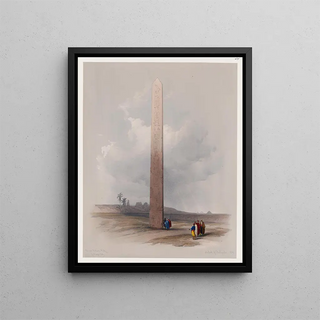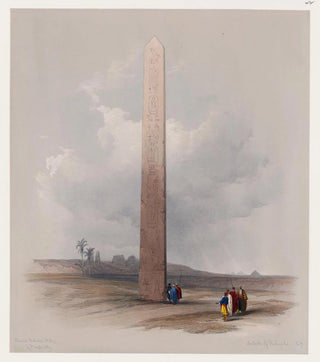Art print | Obelisk of Heliopolis 1839 - David Roberts


View from behind

Frame (optional)
David Roberts' "Obélisque d'Héliopolis 1839" is much more than a simple depiction of an ancient monument. It reflects an era when the East fascinated European artists, a period marked by exploration and discovery at their peak. Through this artwork, Roberts takes us on a journey through time and space, inviting us to contemplate the majesty and mystery of ancient Egypt. The obelisk, a symbol of the power of the pharaohs, stands proudly, defying the passage of time and bearing witness to the grandeur of a vanished civilization. In this art print, every detail is carefully reproduced, allowing the viewer to feel the mystical aura surrounding this iconic monument.
Style and uniqueness of the artwork
David Roberts' style is characterized by striking realism and meticulous attention to detail. In "Obélisque d'Héliopolis," he manages to capture the Egyptian light and atmosphere with remarkable precision. The nuances of color, ranging from warm ochres to deep blues, evoke desert landscapes and the bright skies of Egypt. The shadow cast by the obelisk creates a play of light that emphasizes the verticality of the structure, symbolizing spiritual ascent and the connection between sky and earth. The composition is carefully balanced, highlighting not only the monument but also the surrounding elements that testify to human activity and nature. Every brushstroke seems to tell a story, inviting the viewer to explore the narratives buried behind these ancient stones.
The artist and his influence
David Roberts, born in Scotland in the early 19th century, is considered one of the pioneers of Orientalist landscape. His travels in Egypt and the Middle East profoundly influenced his work, allowing him to capture the beauty and exoticism of these regions. Roberts did not merely reproduce landscapes; he sought to convey an experience, an emotion. His style paved the way for many artists who followed, helping shape Western perceptions of the Orient. Through his works, he was able to awaken

Matte finish

View from behind

Frame (optional)
David Roberts' "Obélisque d'Héliopolis 1839" is much more than a simple depiction of an ancient monument. It reflects an era when the East fascinated European artists, a period marked by exploration and discovery at their peak. Through this artwork, Roberts takes us on a journey through time and space, inviting us to contemplate the majesty and mystery of ancient Egypt. The obelisk, a symbol of the power of the pharaohs, stands proudly, defying the passage of time and bearing witness to the grandeur of a vanished civilization. In this art print, every detail is carefully reproduced, allowing the viewer to feel the mystical aura surrounding this iconic monument.
Style and uniqueness of the artwork
David Roberts' style is characterized by striking realism and meticulous attention to detail. In "Obélisque d'Héliopolis," he manages to capture the Egyptian light and atmosphere with remarkable precision. The nuances of color, ranging from warm ochres to deep blues, evoke desert landscapes and the bright skies of Egypt. The shadow cast by the obelisk creates a play of light that emphasizes the verticality of the structure, symbolizing spiritual ascent and the connection between sky and earth. The composition is carefully balanced, highlighting not only the monument but also the surrounding elements that testify to human activity and nature. Every brushstroke seems to tell a story, inviting the viewer to explore the narratives buried behind these ancient stones.
The artist and his influence
David Roberts, born in Scotland in the early 19th century, is considered one of the pioneers of Orientalist landscape. His travels in Egypt and the Middle East profoundly influenced his work, allowing him to capture the beauty and exoticism of these regions. Roberts did not merely reproduce landscapes; he sought to convey an experience, an emotion. His style paved the way for many artists who followed, helping shape Western perceptions of the Orient. Through his works, he was able to awaken






